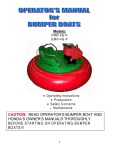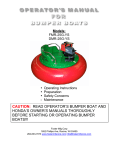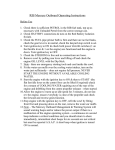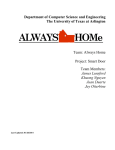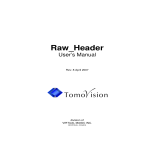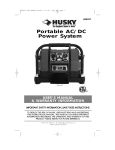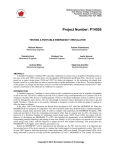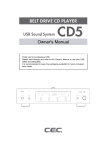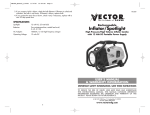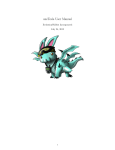Download Electric Boats - Bumper Boats by Foster
Transcript
Models: DMR-075-E DMR-075-E6 • Operating Instructions • Preparation • Safety Concerns • Maintenance WARNING: Read Rules and Instructions carefully before using the Bumper Boats! CAUTION: READ OPERATOR’S BUMPER BOAT AND BATTERY CHARGER OWNER’S MANUALS THOROUGHLY BEFORE STARTING OR OPERATING BUMPER BOATS!!! 2 PREFACE Ride Safety Limitations Hazardous Environmental Conditions Emergency Shut Down Procedure Pool Requirements Operation and Service Manual IMPORTANT RIDE LIMITATIONS 3 • Height Restrictions: Operator: 48” Minimum Passenger(s): 32” Minimum • Number Of Boat Occupants Per Boat: Standard Multiple Rider: (1) Operator (1) Passenger Deluxe Series Multiple Rider: (1) Operator (2) Passengers • Weight Restriction/ Total Rider Capacity: 300 Lbs. Maximum • Operator/ Passenger Seating: Operator: Feet on floor and back to the seat. No sitting on edge of the seat. Passenger Seating: In defined seat area Back to the seat Never on the Operator’s Lap Never between Operator’s Legs Never on Operator’s Leg HAZARDOUS ENVIROMENTAL CONDITIONS THAT MANDATE THE SHUT DOWN OF THE BUMPER BOAT RIDE AND ACTIVITY 4 Electrical Storms: Never operate Bumper Boats when Lightning is present or strong potential of developing soon. An unprotected electrical source is near the pool. All electrical must be protected by proper G.F.I. devices. Flammables or Explosives are present or near the pool. Clarity of the water is obscured or cloudy. Must be able to see the bottom of the pool at all times. Unsafe Water Conditions are present. • Too much chemicals have been added to the water. (Excessive Chlorine) • Polluted water (Bacteria Concerns) present in the pool causing unsafe conditions. EMERGENCY PROCEDURE FOR SHUTDOWN FOR ALL BUMPER BOATS WITH ELECTRIC MOTORS 5 Electric Bumper Boats have no power to the Drive Motor until the Motor’s starter switch is depressed. All Riders must be instructed verbally as to how the drive motor is started and stopped before the ride activity is allowed to start. Procedure to shutdown an operating Electric Bumper Boat is to completely release the Normally Open, Momentarily Closed contact switch. After the Electric Motors have shut down and the Boats are secured to the Dock, riders must be instructed and helped to leave the boat area immediately. Models: DMR-4G-P DMR-4G-P 6 -POOL REQUIREMENTSPool Sidewall 48” Water Depth 36” IMPORTANT INFORMATION It is EXTREMELY IMPORTANT that this complete manual is read, understood and instructions adhered to before and while using and installing batteries, chargers and boats. 7 MANDATORY SAFETY CONCERNS AND PROCEDURES! Potential explosive gases are always present and associated with batteries because they give off gases. Keep flames, ignited cigarettes, cigars or anything that might contribute to ignition away from batteries at all times. Always wear eye and face protection when working near or around batteries. During even normal battery operation, hydrogen gases are being produced. Batteries emit these gases through the vented caps and may form an explosive atmosphere around the battery if ventilation is poor. Explosive gases may be present and continue to be present in and around the batteries for several hours after the charging cycle. Despite the most modern vent cap technology, an external spark may ignite the gases within or around the battery. Anyone in the vicinity of an exploding battery could receive injuries from acids or flying pieces of the battery itself. Never lean over a battery during testing, charging or making connections. Never break a “LIVE CONNECTION” at the terminals or receptacles because a spark will usually occur at the point where the live connection is broken. ALWAYS be certain that all electrical connections are clean and tight, making good connections. REMEMBER… a poor connection can cause an electrical arc, which could ignite the gases and cause the battery to explode. USING THE BATTERY CHARGER NEVER, REPEAT; NEVER… turn the battery charger on until the plug from the charger has been properly installed into the charging receptacle. ALWAYS, REPEAT; ALWAYS… turn the charger off before disconnecting the charger’s plug from the charging receptacle. The room or compartmental area in which the batteries are charged must be well ventilated. It must always be assumed that dangerous hydrogen gases are present within the battery at all times. Always wear eye and face protection when working near or starting the charging cycle. READ THE COMPLETE INSTRUCTION SHEET THAT ACCOMPANIES THE CHARGER. DO NOT USE THE CHARGER UNTIL COMPLETE INSTRUCTION SHEET HAS BEEN READ AND UNDERSTOOD. 8 PREPARATION PROCEDURE FOR BUMPER BOATS WITH ELECTRIC POWERED PROP/JETS Step 1: Inflating Bumper Boat Tube The floatation tube is made of very durable and tuff PVC material. Because of the heavy wall thickness and material hardness, minimum air pressure is required. The tube should be inflated so that it feels firm to the touch. Never inflate the tube so that it feels “rock hard”. If a low range pressure gauge is available, it should be used to determine when the tube has been inflated to 2½ - 3 psi. NEVER INFLATE TO MORE THAN 3 psi AT ANY ONE TIME!!! Note: After the tube has been inflated pour a little water around the valve stem to verify that it is not leaking. Once the valve stem is capped, the tube can be placed in the water with the stem in the water instead of facing up. A valve stem that is not readily accessible sometimes is better because it will not be tampered with and the chance of overinflating the tube is reduced. Step 2: Assembly of Fiberglass Boat into the Tube The insertion of the boat body into the center of the PVC tube will be a tight fit (especially the first few times). The fit is designed to be tight because of the nature of vinyl to stretch somewhat after initial use. Lay the floatation tube on a flat surface with the valve stem facing down preferably. Squirt a soapy water mixture around the inside of the tube and around the bottom of the fiberglass boat. Position the boat in the center of the tube and apply equal pressure on both sides of the boat (requires a minimum of two people) at the same time, forcing the boat down into the tube. Note: The straighter the boat is pushed into the tube, the easier it will be to accomplish this procedure. The boat should be settled into the tube until the rim rests against the tube. Step 3: Installing the Batteries into the Boat It is advisable to have the tube with the boat body in the water before installing the batteries. CAUTION: Batteries are HEAVY (approx. 66 lbs/each). Be careful not to strain your body. It is advisable to ask for help rather than hurting yourself. To install the batteries it will be necessary to carefully move the wiring harness out of the way of the batteries so as not to pinch or damage wires. Lower the batteries carefully into their proper spaces. Note: Each battery will be wired in series and it is extremely important that the batteries are installed so that the sequence and location of the terminals is as shown in the battery compartment photo. Note: Wiring harness is made to fit based on proper battery orientation. The connection ends of the wires will be color coded so if the batteries are purchased from Foster Manufacturing they will be tagged with the proper matching colors. If batteries are not purchased from Foster, refer to the wiring photo for verification. With the batteries in the proper location the connections can be carefully made using EXTREME CAUTION that the wire ends do not come in contact with improper terminals. 9 Contact of the wrong wires with the wrong terminals will result in an arc or spark and this could present the possibility of damage or HARM! After all connections have been made and verified as being correct, secure terminals with the terminal wing nuts. Step 4: Installing the Electric Prop/Jet into the Boat Remove four (4) 3/8”-16 wing nuts at the mounting hole in the floor of the boat. (Leave the four (4) 3/8” split lock washers on the mounting studs.) While lowering the lower unit of the Prop/Jet through the floor of the boat, align the four (4) holes in the mounting bracket to the studs in the floor. Once in position, secure the bracket to the studs using the four (4) 3/8”-16 wing nuts that were removed. Note: When lowering the Prop/Jet into place be careful to properly route the two (2) cords so that they go through the rope time in the front. (Refer to Photo D.) Note: The proper position of the mounting bracket will have the rope tie facing out over the front of the boat. (Refer to Photo D.) Step 5: Making Electrical Plug Connections to the Prop/Jet Assembly Refer to the receptacle Photo B. CAUTION! Be careful not to touch plugs together because it will cause a spark and blow a fuse. ALWAYS work with one plug at a time, leaving the ends of the plugs covered until they are ready to be installed into the receptacle. Note: Plugs will only go into the receptacles if the proper orientation is done to the receptacle. Once the plug is properly installed and is completely into the receptacle it will be rotated slightly clockwise to lock and create a watertight connection. Note: When removing plugs, rotate slightly counter-clockwise before trying to pull out of the receptacle. CAUTION: As soon as one of the plugs has been removed it should have the protective cap reinstalled. The same procedure of installing the protective cap should be followed when the second plug is removed. (Refer to Photo C.) Optional Squirting System If the Electric Prop/Jet is set up with a squirting system it will have a second control system set-up. Depressing the tab over the second switch will start the water pump. Release the tab and the pump will shut off. The ¼” diameter suction line must be below the water line at all times. Note: Squirting pump is located under the motor’s shroud. The squirting pump is outfitted with an inline fuse to protect the pump’s motor and an inline water filter is installed on the suction side of the pump. 10 INSTALLING PROPER PLUGS INTO PROPER RECEPTACLES Plugs and receptacles have been color coded so the correct match up of the plug and receptacle is made easy. Note: Looking at the plug on the end of the supply cord, be certain that the “Green matches Green” and “Blue matches Blue”. (REFER TO PHOTO B) PROTECTIVE CAPS Whenever the electric supply cords are not securely installed in the proper power receptacle they should have the protective caps in place. Note: If the plugs of both cords were to touch each other it would cause a spark and blow a fuse. (REFER TO PHOTO C) PROPER ROUTING OF ELECTRICAL SUPPLY CORDS TO MOTOR ASSEMBLY When the electric motor assembly is mounted in the boat the proper routing of the electrical supply cords is through the rope tie. Note: Be careful that proper plugs are installed in the correct receptacles. Look at the color codes for proper match up. (REFER TO PHOTO D) 11 BATTERY COMPARTMENT SHIPPED WITHOUT BATTERIES New boats are shipped from the factory without the batteries installed. If the batteries were purchased from Foster Manufacturing they will be marked #1, #2, #3 and have color codes for proper battery terminal connections. NOTE: Model DMR-075-E Will have (3) 12 volt batteries marked 1, 2, & 3. NOTE: Model DMR-075-E Will have (6) 6 volt batteries marked 1, 2, 3, 4, 5, & 6. If the batteries are being purchased separately from others, it will be necessary to follow the Battery Wiring Illustration supplied in this manual. NOTE: For models DMR-075-E refer to the battery compartment illustration with (3) 12 volt batteries. NOTE: For models DMR-075-E6 refer to the battery compartment illustration with (6) 6 volt batteries. (REFER TO PHOTO E) 12 13 14 WIRING ILLUSTRATION FOR MODEL DMR-075-E KEY NO. #1 #2 #3 #4 #5 #6 #7 #8 #9 #10 #11 #12 #13 #14 #15 #16 DESCRIPTION AND ROUTING - Battery #1 Black Wire from Charging Receptacle +Battery #2 White Wire from Charging Receptacle - Battery #1 Black Wire from Gauge +Battery #2 White Wire from Gauge - Battery #1 Black Wire to Diode (bottom terminal solenoid) - Battery #1 White Wire from Blue Cord Set - Battery #1 Black Wire from Blue Cord Set Top Terminal of Solenoid, Black Wire from Green Cord Set Bottom Terminal of Solenoid, Green Wire from Green Cord set +Battery #1 White Wire from Green Cord Se +Battery #2 White Wire Top Terminal of Solenoid +Battery #3 to -Battery #2 Jumper +Battery #1 to -Battery #3 Jumper - Battery #2 Black Wire of Bilge Pump +Battery #2 Brown Wire of Bilge Pump Diode connected to Bottom Terminal of Solenoid and #5 Wire FUSES IN SYSTEM #6 #11 #7 #15 #10 20 Amp Slow-Blow 25 Amp Slow-Blow 20 Amp Slow-Blow 2 ½ Amp Slow-Blow 20 Amp Slow-Blow Note: Squirting Pump has separate fuse located at the pump. 15 16 WIRING ILLUSTRATION FOR MODEL DMR-075-E6 KEY NO. #1 #2 #3 #4 #5 #6 #7 #8 #9 #10 #11 #12 #13 #14 #15 #16 #17 #18 #19 DESCRIPTION AND ROUTING Black wire from Gauge to – Post Of Battery #6 Black wire, Diode Connection, Bottom Solenoid Terminal, - Post Battery #6 Black wire from Charging Receptacle, -Post Battery #6 Red wire Fuse Set, - Post Battery #6, connected with White wire of Blue Cord Set Black wire from inside Circuit Breaker, -Post Battery #6 Black wire from Bilge Pump, -Post Battery #4 White Jumper, - Post Battery #5 to + Post Battery #6 White Jumper, - Post Battery #3 to + Post Battery #4 Red wire Fuse Set, + Post Battery #3 to Brown wire of Bilge Pump White Jumper, - Post Battery #2 to + Post Battery #3 Red wire Fuse Set, - Post Battery #4 connected with White wire of Green Cord Set White wire from Charging Receptacle, + Post Battery #1 Black wire from Inside Circuit Breaker to Black wire of Blue Cord Set White Jumper, - Post Battery #1 to + Post Battery #2 White wire from Gauge, + Post Battery #1 Green wire of Green Cord Set to Bottom Terminal of Solenoid Switch White wire from Outside Circuit Breaker, + Post Battery #1 Black wire from Green Cord Set, to Top Terminal of Solenoid Switch White wire from Outside Circuit Breaker, to Top Terminal of Solenoid Switch FUSES IN THE SYSTEM #4 Fuse Set: 20 amp Slow-Blow #9 Fuse Set: 2 ½ amp Slow-Blow #11 Fuse Set: 20 amp Slow-Blow SYSTEM CIRCUIT BREAKERS #5 Inside Circuit Breaker 25 amp Thermal Reset Type #17 Outside Circuit Breaker 25 amp Thermal Reset Type 17 MAINTENANCE PROCEDURES AND CONCERNS FOR ELECTRIC POWERED PROP/JETS Maintaining the Performance of the Prop/Jet Although the Electric Prop/Jet is very simple in design, it requires routine inspection. The routine inspection procedure should be followed to assure good performance and minimal down time. Reference Upper Unit Assembly 1. Inspect the electrical switch(es) to assure they are functioning properly and are in proper condition. 2. Inspect and verify that switch(es) are functioning properly. It is only necessary to have slight contact to actuate the control switch(es). 3. Routinely check all fasteners, tighten if necessary. CAUTION: When removing fasteners be certain to re-install with a thread adhesive “Loctite”. 4. Routine inspection of the motor’s shroud to verify it is properly installed and secured. Note: NEVER!!! Operate the Electric Prop/Jet without the motor’s shroud in place. There is the possibility of SEVER BURNS AND GREAT DANGER OF ELECTRICAL SHOCK AND HARM FROM THE ROTATING FAN BLADE. 5. Routine inspection of the condition and proper installation of the electrical supply cords and waterproof plugs. Reference Swivel Bracket Assembly and Steering Bushings 1. Routine inspection of the swivel bracket assembly. Inspect the four (4) socket head cap screws making certain they are tight and secure. 2. Routinely grease the swivel bracket to avoid premature wear on the steering bushings. Replace the bushings when they show excessive wear. Allowing excessive wear on the bushings without replacing them will cause damage to the swivel bracket itself as well as damage and wear to the other components. 3. Inspect drive shaft housing tube bushings to make sure it is not rotating on the tube. This bushing should not rotate on the tube; it is intended to protect the tube from wear. Note: Bushing is held in place on the tube by both compression force developed by the four S.H.C.S. as well as a 5/16”-18 cup point set screw on the backside. Note: Apply water-resistant grease to the bushing and backup thrust block routinely. 4. Inspect steering bushings for proper functioning. The larger, outside bearing is intended to be held stationary to the swivel bracket. It is held by the 7/16” O.D. stainless tube nipple that sticks into the sidewall of the bearing. 18 The smaller, inner bearing is intended to be held stationary to the motor’s mounting casting. It is held by the end of one of the ¼”-20 S.H.C.S. entering a hole in the bearing’s flange. Note: Wear and pivoting is done between the two bushings when they are properly installed. Note: Proper procedure for greasing the steering bushings is to pivot the assembly at the same time as applying grease. It is EXTREMELY IMPORTANT THAT THE MOTOR ASSEMBLY IS ROTATED WHILE APPLYING GREASE TO ASSURE PROPER DEPOSIT IN ALL OCATIONS. ALWAYS USE WATER RESISTANT GREASE. Reference Lower Gear Case Assembly For Model FPJ-075-P 1. Periodic inspection of the gear case is a good practice. Be certain that the end caps are tightly in place and there is no leakage. Note: End caps are held from rotating or loosening by one cup-point set screw on each end of the gear case. CAUTION: When removing the setscrews be certain that before they are re-installed “Loctite” is applied to the threads. CAUTION: BE CAREFUL NOT TO OVERTIGHTEN SETSCREWS! Note: When removing end caps a 2” spanner wrench is required. Be careful not to cut “O” rings or pinch them when reinstalling the caps. Note: Gear case assembly has been “serviced” at the factory with a “premium quality” S.A.E. 80w-90w-gear lube. Recommended capacity is 9 ounces. 2. It is recommended that gear case lube be changed once a year. Procedure to follow is as outlined: A. Position the engine in the upright position. B. Place an adequate size container under the gear case. Capacity should be one (1) quart size or larger. C. The back gear case cap will be removed to drain the gear lube. Loosen setscrew that is at the edge of the cap. Using a 2” spanner wrench turn the cap counter-clockwise removing it from the case. Allow all the gear lube to drain out. D. To refill gear case position the Prop/Jet on the floor. Position the lower unit so that it is resting on the propeller guard. Now place blocking under the guard so to support the lower unit. Raise the lower unit until the drive shaft housing tube is horizontal to the floor. E. Fill the gear case with “Premium Grade” gear lube, S.A.E. 80w-90w. Allow time for the gear lube to purge through bearings. (Raise the lower unit so it is higher than the motor causing the whole bearing cavity to fill in the drive shaft tube.) Return the lower unit to a level position and refill the case to the top of the backside of the driver gear. Total volume of gear lube being used is approximately 13 ounces. F. Apply a film of grease to the “O”-Ring on the end of the cap. Re-thread cap into the gear case using the 2" spanner wrench. 19 CAUTION: Make sure that cap is completely re-installed. (Properly positioned the flat shoulder of the cap will stop at the flat shoulder of the gear case.) The end cap will be flush with the gear case. G. Completely remove the setscrew at the edge of the gear case. Clean the setscrew and apply “Loctite” and re-install. Do Not Over Tighten! 3. Inspect the propeller guard assembly to make certain it is secure to the gear case. 4. Inspection of zinc anode should be done periodically. Replace the anode when signs of significant deterioration are present. Daily Inspection Required Flotation Tube: Tube should be visually inspected for cuts, leaks and potential leaks. Tubes are made of vinyl and should be cleaned frequently and a vinyl protector applied to protect the tube and keep it from getting hard. Fiberglass Boat: Visual inspection should be done that all fasteners are secure. Visual inspection of the fiberglass structure to identify any cracks or rough surface areas that rider(s) might come in contact with while they are in use of the boat. Mounts and Controls: Welds should be inspected (i.e.) handle bar, mounting bracket and guards. Fasteners should be checked for proper torque. Electrical switch(es), plugs, receptacles and bilge pump for proper functioning. Inspect for proper greasing level for swivel bracket. Use water resistant type grease. Note: Routinely inspect that all units have propeller guards in place and they are securely installed. NEVER… NEVER operate bumper boats without propeller guards in place. 20 TROUBLE SHOOTING Problem: Electric motor will not start. Possible Cause Corrective Action Electrical supply cords are not correctly plugged into motor’s receptacles. Circuit Breakers tripped in supply cord. Broken or disconnected electrical wire. Defective or broken starter switch. Battery charge is completely drained Properly install and lock plugs into proper receptacles. Reset Circuit Breakers. Inspect for broken or disconnected wire. Check switch and replace if defective. Check gauge and recharge if drained. Problem: Electrical system frequently blowing fuses. Possible Cause Corrective Action Wrong size and/or type of fuses. Motor supply wires should have 20 amp slow blow fuses installed. Remove any debris that might be wrapped around the shaft. Inspect and replace defective bearings. Replace or re-position to proper mounting distance. If motor is drawing excessive current consult factory. Restriction of movement at the propeller shaft. Failed bearings in lower unit. Damaged or misaligned gears in lower unit. Defective or short-circuiting drive motor. Problem: Diminished speed or no power. Possible Cause Corrective Action Very low battery charge. Faulty or defective starter switch. Restriction of inlet side of propeller guard. Shear pin broken. Worn or damaged propeller. Key loose/out of drive gears. Short-circuiting of drive motor. Recharge batteries completely. Replace defective switch. Clean propeller guard screen. Replace shear pin. Replace propeller. Inspect and reinstall or replace. Have a qualified electrician verify and replace if necessary. Problem: Bilge pump not functioning. Possible Cause Corrective Action Blown fuse. Disconnected wires. Debris lodged in impeller. Faulty float computer chip or defective motor. 21 Replace w/2 ½ amp slow blow. Reconnect wires properly. Clean and remove debris. Repair or replace unit. OPERATING PROCEDURE FOR BUMPER BOATS Note: Operation can be done only after proper wiring installation has been done and batteries are adequately charged. CAUTION: All attendants involved in ride operation should be well informed and familiar with “Rules of Safe Operation,” motor characteristics and control functions of the bumper boats. All boats should go through a Daily Checklist for inspection prior to making the boats available to the customers. Record keeping is important. Step 1: Loading assistance of rider(s) should be offered to avoid accidents due to slipping or falling. Before the ride starts, the rider(s) must be seated completely and “Rules of Safe Operation” and instructions should be thoroughly reviewed with the riders. If the passenger’s height is less that 12” greater than the water’s depth, a floatation life vest should be supplied to the passenger(s) before they are allowed on the platform. Step 2: The attendant should instruct and familiarize the rider to the operational control(s). The boat is powered by depressing the switch on the right of the handle assembly. (Refer to Photo A.) A. Press switch and drive motor starts and will immediately come up to maximum speed. As long as the switch is held the motor will run at maximum speed. B. Release the switch and the drive motor stops rotating immediately. Note: There is only one speed and there is no throttle provided. Step 2a: An Electric Prop/Jet set up with a squirting system will have a second energizing switch located on the left side of the handle assembly. (Refer to Photo A.) A. Press switch and the pump will start pumping water to the squirting nozzle and a stream of water will start coming out of the nozzle in the shroud. B. Release the switch and the pump will stop and so will the stream of water. Step 3: After the rider is familiar with the boat’s operational functions and “Ride Rules” the ride is ready to start. The attendant should untie and release boats from the “Loading Platform” when the ride cycle is started. Note: For safety reasons all riders should be seated completely before any boats are released. Note: Bumper boats must be monitored at all times by ride attendant(s). Step 4: When the ride cycle is completed, the rider(s) should be directed to return to available boat slips. The ride attendant(s) should securely tie boats to the “Loading Platform”. Note: All boats should be tied to the loading platform before any rider(s) are allowed to depart. 22 Step 5: Ride attendant(s) should supervise that the departures are “Orderly and Safe” and that all customers that have completed their rides leave the area before starting to load the boats with new riders. Note: Each boat is equipped with a gauge on the back of the seat and it should be monitored throughout the operating day (read the top scale, for 36 volts.) to assure that there is an adequate charge in the batteries. Procedure to Charge Batteries Note: Verify and be certain that all electrical outlets and connectors meet or exceed all state and local electrical codes around and near a water environment when chargers are being used. Note: Thoroughly read and understand the batter charger’s operating instructions. NEVER, repeat NEVER take a chance. ELECTRICITY AND WATER DO NOT MIX! CAUTION: MAKE CERTAIN THAT THE CHARGER IS OFF WHILE PERFORMING STEP 1. Step 1: Lift the protective cap from the charging receptacle on the back of the seat. Insert the plug from the battery charger. Note: Plug will only go into the receptacle if proper plug orientation to the receptacle is accomplished. Once the plug is properly installed and completely inserted in the receptacle it will be rotated slightly clockwise to lock and create a watertight connection. When removing the plug it must be rotated slightly counter-clockwise before it is pulled out of the receptacle. DO NOT APPLY EXCESSIVE FORCE OR ROTATE MORE THAN SLIGHTLY. Step 2: After proper connection has been made between the charge and the boat to be charged, power may not be turned on for the charger. Inspect the gauge on the backside of the seat to verify that the system is indeed charging. Note: ALWAYS VERIFY THAT POWER TO THE CHARGER HAS BEEN TURNED OFF BEFORE DISCONNECTING THE CHARGER’S CORD/PLUG FROM THE BOAT’S CHARGING RECEPTACLE. 23 Pre-Opening Inspection Recorded Record for Week Ending _________ BOATS 1. 2. 3. 4. 5. 6. 7. 8. 9. 10. 11. 12. 13. 14. 15. 16. 17. Sunday Monday Tuesday Wednesday Thursday Friday Check battery gauge to verify full charge. Inspect connections to the electric motor. Check condition of supply cords to motor. Check battery compartment-condition of wires and connections. Check for water in battery compartment, bilge pump working. If applicable, check pump switch for squirting system. If applicable, check for water flow from squirting pump. Verify complete propeller guard assembly is in place and secure. Inspect fasteners and fittings and tighten properly if loose. Inspect swivel bracket assembly to verify it is secure and lubricated. Inspect fastening wing nuts that secure mounting bracket to the floor of the boat. Make sure they are tight. Inspect for proper assembly and integrity of all guards for safe operating conditions. Inspect batteries for proper water level and properly installed vent caps. Inspect and clean any corrosion at battery or wiring connections. Inspect tube condition for floatation. Observe for signs of leakage. Clean motor shroud, boat and tube to assure a safe ride. Start motor and test ride boat to verify proper operating conditions. POOL AND SURROUNDINGS 1. Check water chemistry. Inspect for harmful water conditions. 2. Inspect the condition of rope ties for docking boats. 3. Verify the condition and stability of handrails. 4. Verify that “Rules of Safe Operation” are properly positioned and visible. 5. Check fire extinguishers and verify proper placements. 6. Check integrity of fences and gates for proper functioning. 7. If operating instructions and “Rules of Safe Operation” are delivered to customers via a recording, verify proper functioning and clarity. 8. Remove all flammable materials from ride area. 9. Remove all electrical cords and any potential spark generating devices. Note: These are basic concerns that should be addressed on a routine schedule. Each operation, depending on its own requirements should add to, but not eliminate from this checklist. 24 Saturday Rules for Safe Operation • Thoroughly read and understand complete operator manuals before operating Bumper Boats. • Thoroughly read and understand instructions pertaining to proper and safe use of Battery Chargers. • Always exercise concern while working around batteries. Wear safety goggles and face protection when inspecting or charging batteries. • Take precautions against fire and sparks. Fire fighting equipment should be readily available and accessible at the bumper boat activity. • Handle batteries with care. When replacing or removing batteries be EXTREMELY CAREFUL that loose or inappropriate wires do not come in contact with battery terminals, solenoid or other connections. • Never charge batteries when people are in or around the boats. • Routinely remove corrosion from terminals and connections. Periodically apply anti-corrosion protection to terminals and connections. • Never recharge batteries in an enclosed or poorly ventilated area. • When an electric motor starts operating intermittently it should be immediately taken out of service until the problem can be determined. There could be a chance of sparking from a short circuit. • Always remove inline fuses and disconnect main power to the electric motor prior to doing any work on the motor or batteries. • Never replace fuses with those of a greater value or type. • Always make sure that any ELECTRICAL SERVICE or SUPPLY near the pool is protected by PROPER GROUND FAULT protection. Consult with local governing agencies. • Make a routine check that all nuts, bolts, screws and fittings are tight. • Never operate the motor with any of the guards missing, broken or incomplete. • Never allow observers, swimmers or by-standers to be in the water while bumper boats are operating or capable of operating. • Never allow small riders to sit on an adult’s lab or between their legs. All riders must sit on the seat with the back(s) against the back of the seat. • Operators of bumper boats must be tall enough to sit completely back in the seat with their feet on the floor of the boat. • When a rider’s height is not at least 12” greater than the water’s depth, a life preserver should be provided. • Never allow “Standing” or “Kneeling” on the bumper boats. • Unusual or excessive noise should be checked immediately. Turn off the electric motor and review all components. • Maximum rider(s) weight capacity is 300 lbs. • No food or drinks are allowed while in the bumper boats. • No smoking is allowed while in or around the bumper boats. • Signs must be posted stating that riders use the bumper boats at their own risk. • Propeller guards must always be in place when using bumper boats. If the boats are in the general ride area, they must have complete sets of proper guards installed. • Signs should be posted that caution person(s) who are pregnant or have experienced back or neck problems that they should not ride bumper boats. People with “heart conditions” should not ride bumper boats. • When disconnecting main electrical plugs from the motor’s receptacles, one plug should be removed at a time and the prongs on the plug covered before the second plug is disconnected at which time the prongs on the second plug must be covered. • Always record and keep complete records and accident reports when they involve personal injury. No matter how slight the injury seems at the time, it could be crucial at a later date. 25
























